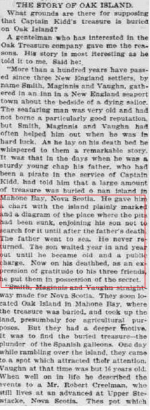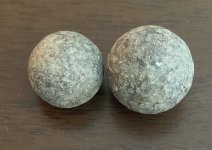gjb
Full Member
- Apr 21, 2016
- 240
- 307
- Detector(s) used
-
Garrett Ace 300i
Garrett EuroAce
- Primary Interest:
- All Treasure Hunting
Your work deriving this...Is to be...Admired!
Oh!...By the way...You can run from the Oak Island Forum...But you cannot...Hide!
Having had no response to this topic in the forum’s General Discussion (apart from Robot’s observation above) I thought I might try here possibly for one last time (due to a serious health condition).
While I appreciate that this subject has not been discussed on The Curse of Oak Island may I respectfully submit that the historical aspects of the series are not exactly a paragon of Oak Island research.
If there really is a treasure on Oak Island, why is there such an insistence that it has to be in the Money Pit? One potentially significant aspect of Oak Island is constantly overlooked - even dismissed as irrelevant. I refer to the several ground markers on the island specifically those at the east: the Drilled Rocks and the Stone Triangles. If these be original then they must have had a purpose more likely other than to draw attention to the Money Pit. By all accounts, this was far more obvious than any of the other ground markers (and I consider the Money Pit to be a ground marker, not somewhere you necessarily have to dig).
What if these features were not randomly positioned but were placed at strategic points on a ground plan - in effect, at key locations on a geometrical design - and that they were intended to be used to locate a point on the island other than the Money Pit?
Furthermore, what if, by taking the suggestion seriously, it were possible to recreate the original ground plan from knowledge of where these markers were reported to have been found? Maybe this might reveal a potential hot-spot for investigation.
I appreciate that these ground markers have been mostly wantonly destroyed and removed as being unimportant in the great scheme of things, but what if this continuing cavalier attitude to Oak Island is wrong? Also, what if the almost haughty preconceptions of writers on the mystery has influenced researchers to reject the very information that’s required to make use of these markers?
What if instructions were left to enable someone to relocate the island’s hot-spot? Unfortunately, such instructions would be likely to take the form of an item seemingly despised and disparaged by people claiming to have the intelligence and sense not to be so gullible. I refer, of course, to what would be termed a ‘treasure map’.
This would not have to be a simple ‘pirate’ treasure map as in Treasure Island but a sophisticated mechanism in keeping with the apparent engineering skills of the originator of the enterprise. The purpose might simply be a contingency plan - a back-up in the event of anything happening to him.
I believe there is a possibility that sets of instructions dismissed by the majority of people as being the worthless fabrications of forgers and scammers may have been erroneously assessed and that when correctly interpreted and applied to the ground markers on Oak Island reveal a regular pattern of points on the ground.
I’ve written a series of books on the subject, but I’ve put together a web page presenting a geometrical plan of the east of the island and indicating how the instructions appear to work and where they lead. The question would then be: could this be coincidence?
I had hoped for some comments on the general forum about whether it is likely that anyone would create instructions for relocating a deposit - potentially by their heirs in the event of an untimely accident rendering them incapable of recovering it themselves, or simply as a bequest. Of course, the heirs could be a group of people with a goal that needed future financing (revolution etc.)
Maybe discussion here might get back to focus on Oak Island rather than on The Curse of Oak Island, though one of the maps has appeared more than once in the series. However, the reconstruction and the associated instructions as developed here use typically British / Colonial units of measure (the baseline shown is three sections of 15 rods and the flood tunnel would be 30 rods = 495 feet). There is far more to the geometry than this, but see the link below:
Oak Island Geometry and Treasure Maps
In closing, I apologise if deteriorating health does not permit me to maintain a discussion.








